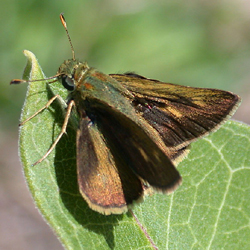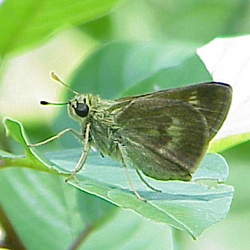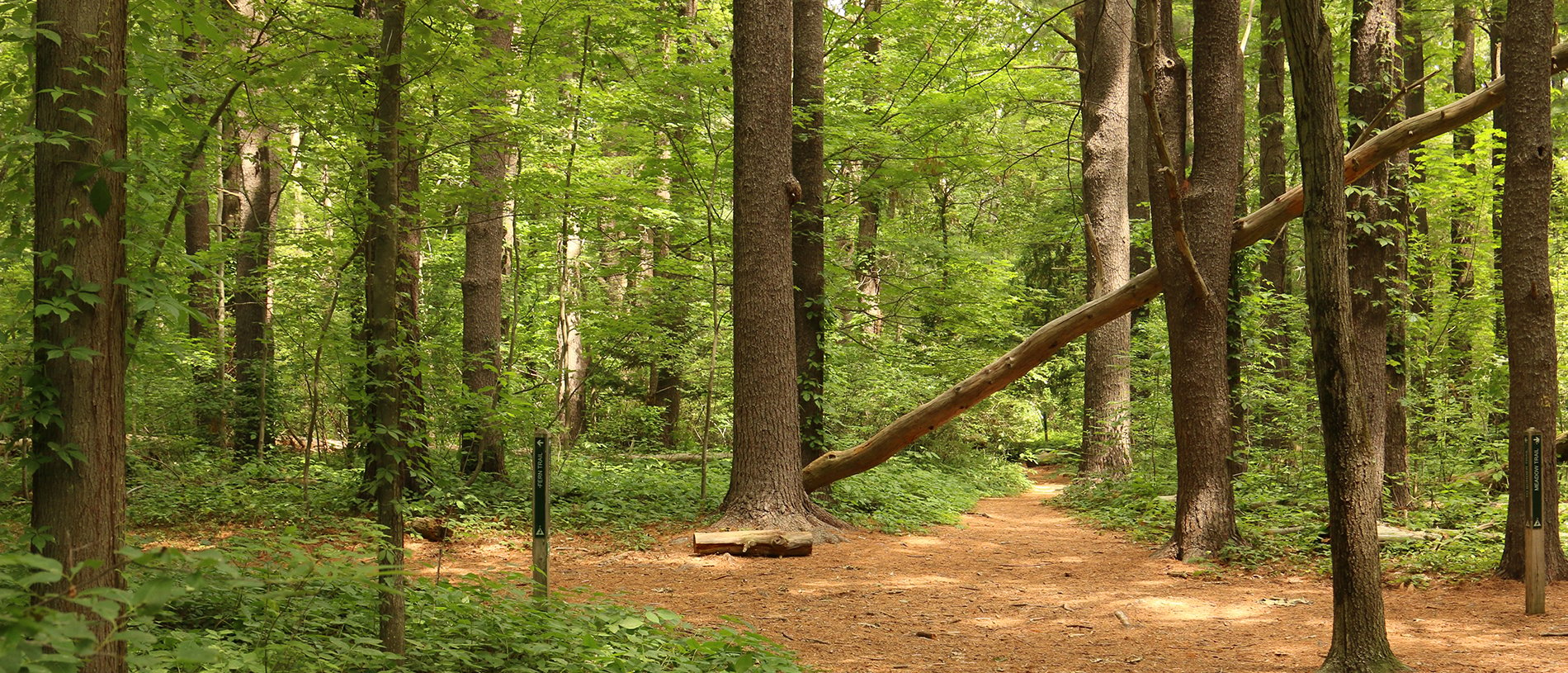Find a Butterfly
Northern Broken Dash
Wallengrenia egeremet
Named
Scudder, 1864

Taxonomy & Nomenclature
Once considered the northern subspecies of Wallengrenia otho, which is now distinguished as the Southern Broken Dash. Many references call otho simply Broken Dash. This species was described by Scudder (as Thymelicus aetna, the Volcanic Skipper!) from a type specimen taken in Massachusetts.
Identification
Wingspan: 1 - 1 1/4". A dark, obscurely marked little skipper typically with a suffusion of yellowish scaling at the wing bases and the center of the hind wings above, especially in males. The male is best identified by the "broken" stigmal marking, which resembles a slanted exclamation point with the dot nearest the wing base and the slash extending parallel to the leading edge of the forewing; a little yellowish "flag" extends from the outer tip of the black slash. The female is one of the notoriously confusing "black witches", best identified by comparing the form of the largest (median) spots of the forewing above with those of its look-alikes, especially Cross-line, Dun, and Little Glassy Wing. The most prominent, squarish forewing spot of female egeremet is usually yellowish and rectanglar with a strongly concave outer edge. When viewed from below in the closed-wing position note the overall tannish ground color and vague crescent- shaped spot band on the hindwing.
Distribution
Eastern North America from eastern North Dakota and northern Texas across southern-most Ontario and Quebec to eastern Maine and south to northern Florida. In New England absent from northern Maine and apparently scarce or absent in northernmost Vermont and New Hampshire.
Status in Massachusetts
Common locally throughout the state. Atlas records indicate that it may be more numerous in the East. Maximum: 10 on 12 July 1989, Orleans (Barnstable Co.).

Flight Period in Massachusetts
Typically early July to mid-August. Extreme dates: 26 June 1994, Charlemont (Franklin Co.), D. Potter and 12 September 1995, S. Dartmouth (Bristol Co.), B. Cassie.
Larval Food Plants
Panic grasses, especially larger species: Deer Tongue Grass (Panicum clandestinum) and P. dichotomum.
Adult Food sources
Noted on 17 species of wildflowers during the Atlas period; apparent favorites include: milkweeds, New Jersey Tea, Red Clover, dogbanes, Sweet Pepperbush, Buttonbush, and others; also drinks at wet spots on the ground.

Habitat
Poorly defined. Apparently ranges freely over a variety of both wet and upland habitats. Clark and Clark (1951) state that it "avoid(s) the driest localities" and other authors include wood edges among its habitats. Tudor (pers.comm.) says its "a bit ‘trashier‘ than Little Glassy Wing and Dun Skipper, occuring in urban parks where the latter are rare. Its reported nectaring plants are a mix of upland and wetland species. Of the two grass species on which the larva has been found, Panicum clandestinum tends to occur in moist, mainly sandy sites, while P. dichotomum prefers "dry or sterile woods" (Hitchcock, 1950). There seems to be a consensus that its congener, the Southern Broken Dash, prefers wetlands.
Life Cycle
Many details unrecorded. EGG: "Pale pea green" (Scudder, 1889); a hemispherical dome with raised vertical ridges the surface between them densely covered with shallow punctures. OVIPOSITION: Not recorded? Eggs hatch in less than two weeks. LARVA: Pale green to brown mottled with darker and some paler markings and with a dark stripe down the back; sides obscurely striped in yellow and green; head chocolate brown. May be a "case bearer", chewing off bits of vegetation and attaching them to its body as camouflage. CHRYSALIS: Generally green to greenish yellow with brown and pink markings; cylindrical. PUPAL STAGE: No information? OVERWINTERING STAGE: Partially grown larva.
Males are said to perch relatively high (3-6 feet) on exposed twigs, and to pursue mates earlier in the day than related species (Opler and Krizek, 1984).
Account Author
Chris Leahy



